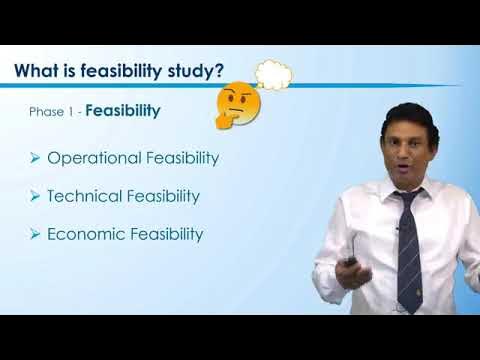6 - Requirement Elicitation
Summary
TLDRThis video covers the essential process of requirement elicitation in software development, focusing on methods for gathering accurate and detailed user requirements. The speaker distinguishes between 'requirement gathering' and 'elicitation,' emphasizing the importance of clear communication to avoid expectation gaps. Various direct elicitation techniques, such as brainstorming, interviews, focus group discussions, and observation, are explored, each with its strengths and challenges. The session also includes a case study on scheduling systems, demonstrating how these techniques can be applied in real-world scenarios to ensure successful project outcomes.
Takeaways
- 😀 Requirement elicitation is the process of identifying and gathering the needs and expectations of stakeholders for a software system.
- 😀 Misalignment between client expectations and the final product can occur if the requirement elicitation process is not properly executed.
- 😀 The process of elicitation helps to bridge the gap between user needs and developer understanding, ensuring that products meet real requirements.
- 😀 Common issues in elicitation include unclear or overly broad scope, incomplete user understanding, and gaps in knowledge between users and developers.
- 😀 Direct elicitation techniques involve direct interaction with stakeholders through methods like brainstorming, interviews, and focus group discussions (FGDs).
- 😀 Indirect elicitation involves reviewing documents or other materials to gather information without directly engaging with users.
- 😀 Brainstorming sessions allow team members to collaboratively generate ideas and solutions for project challenges, but should be time-boxed and focused.
- 😀 Interviews provide a one-on-one opportunity to gather in-depth insights from users, but success depends on the interviewer’s ability to ask probing questions.
- 😀 Focus Group Discussions (FGD) are small, facilitated group sessions that allow stakeholders to share opinions and collaboratively define requirements.
- 😀 Observation techniques involve watching users in their natural working environments to better understand their needs and workflows.
- 😀 Workshops allow a group of stakeholders to collaboratively discuss problems and potential solutions but should be sized appropriately to maintain focus and engagement.
Q & A
What is the main focus of the lecture in the transcript?
-The main focus of the lecture is on requirement elicitation in software development. The lecture explores the techniques and challenges involved in gathering detailed information about user needs and system requirements.
What is the difference between requirement gathering and requirement elicitation?
-Requirement gathering involves collecting information from various sources, while requirement elicitation is a more targeted process where specific information is sought to meet defined goals. Elicitation focuses on understanding and defining the exact needs and constraints from stakeholders.
Why is requirement elicitation considered a critical step in software engineering?
-Requirement elicitation is critical because it ensures that the development team understands the true needs of the users or clients. It helps prevent expectation gaps between the client and the development team, which could otherwise result in misaligned or ineffective product development.
What are the two main types of requirement elicitation methods discussed in the lecture?
-The two main types of requirement elicitation methods discussed are direct and indirect elicitation methods. Direct methods involve direct interaction with stakeholders, while indirect methods gather information from secondary sources such as documents or existing records.
What are some examples of direct elicitation methods mentioned in the lecture?
-Examples of direct elicitation methods include brainstorming, interviews, focus group discussions (FGD), observations, and workshops.
What is brainstorming, and how is it used in requirement elicitation?
-Brainstorming is a technique where team members gather to discuss and generate ideas or solutions to problems. In requirement elicitation, it is used to explore possible solutions and define the project’s goals and needs through group collaboration.
How does an interview function as a requirement elicitation method?
-An interview involves one-on-one conversations between an analyst and a stakeholder. The analyst asks targeted questions to understand the specific needs and expectations of the stakeholder, gathering detailed and focused information.
What is the purpose of focus group discussions (FGD) in the context of requirement elicitation?
-The purpose of FGDs is to bring together stakeholders or users to discuss their goals, challenges, and needs in a group setting. The facilitator encourages participants to share their thoughts and identify common issues and potential solutions.
What challenges are typically encountered during the elicitation process?
-Common challenges include unclear or incomplete requirements, mismatched understanding between users and developers, scope issues (either too broad or too narrow), and the difficulty in capturing all the necessary details from diverse stakeholders.
What is the desired outcome from a successful requirement elicitation process?
-The desired outcome is a clear, complete, and verifiable set of requirements that are consistent, easy to track, and can be effectively used to guide the development process. The information should be organized and free from ambiguity, ensuring that all stakeholder needs are addressed.
Outlines

Cette section est réservée aux utilisateurs payants. Améliorez votre compte pour accéder à cette section.
Améliorer maintenantMindmap

Cette section est réservée aux utilisateurs payants. Améliorez votre compte pour accéder à cette section.
Améliorer maintenantKeywords

Cette section est réservée aux utilisateurs payants. Améliorez votre compte pour accéder à cette section.
Améliorer maintenantHighlights

Cette section est réservée aux utilisateurs payants. Améliorez votre compte pour accéder à cette section.
Améliorer maintenantTranscripts

Cette section est réservée aux utilisateurs payants. Améliorez votre compte pour accéder à cette section.
Améliorer maintenantVoir Plus de Vidéos Connexes

Functional vs Non Functional Requirement

7 - Requirement Elicitation: Part 2 Indirect Elicitation

Software Requirements | Requirement Engineering | Feasibility Study, Elicitation, SRS, Validation

business app development

Requirement Part 1 - Materi 3

Introduction & How to write SRS - Software Requirements Specification Document
5.0 / 5 (0 votes)
